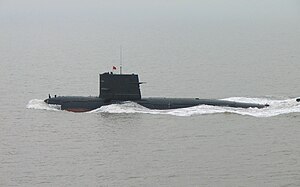
The RUR-5 ASROC is an all-weather, all sea-conditions anti-submarine missile system. Developed by the United States Navy in the 1950s, it was deployed in the 1960s, updated in the 1990s, and eventually installed on over 200 USN surface ships, specifically cruisers, destroyers, and frigates. The ASROC has been deployed on scores of warships of many other navies, including Canada, Germany, Italy, Japan, the Republic of China, Greece, Pakistan and others.

A submarine is a watercraft capable of independent operation underwater. It differs from a submersible, which has more limited underwater capability. It is also sometimes used historically or colloquially to refer to remotely operated vehicles and robots, as well as medium-sized or smaller vessels, such as the midget submarine and the wet sub. Submarines are referred to as "boats" rather than "ships" irrespective of their size.

The German Type 212 class, also Italian Todaro class, is a diesel-electric submarine developed by Howaldtswerke-Deutsche Werft AG (HDW) for the German and Italian navies. It features diesel propulsion and an additional air-independent propulsion (AIP) system using Siemens proton exchange membrane (PEM) compressed hydrogen fuel cells. The submarines can operate at high speed on diesel power or switch to the AIP system for silent slow cruising, staying submerged for up to three weeks with little exhaust heat. The system is also said to be vibration-free, extremely quiet and virtually undetectable.

An attack submarine or hunter-killer submarine is a submarine specifically designed for the purpose of attacking and sinking other submarines, surface combatants and merchant vessels. In the Soviet and Russian navies they were and are called "multi-purpose submarines". They are also used to protect friendly surface combatants and missile submarines. Some attack subs are also armed with cruise missiles, increasing the scope of their potential missions to include land targets.

The Balao class was a successful design of United States Navy submarine used during World War II, and with 120 boats completed, the largest class of submarines in the United States Navy. An improvement on the earlier Gato class, the boats had slight internal differences. The most significant improvement was the use of thicker, higher yield strength steel in the pressure hull skins and frames, which increased their test depth to 400 feet (120 m). Tang actually achieved a depth of 612 ft (187 m) during a test dive, and exceeded that test depth when taking on water in the forward torpedo room while evading a destroyer.

The Maestrale class is a class of frigates of the Italian Navy. The class is composed of eight vessels, all of which were built by Fincantieri S.p.A., Riva Trigoso, except for Grecale, which was built by Fincantieri S.p.A. – Muggiano, La Spezia.

The Barracuda-class submarines were the product of Project Kayo, a research and development effort begun immediately after World War II by the United States Navy to "solve the problem of using submarines to attack and destroy enemy submarines." They originally had the hull classification symbol SSK, for "hunter-killer submarine". It was known that the Soviet Navy had acquired the German Type XXI U-boat and other advanced submarines, and was expected to rapidly put derivatives of them into production. In 1948 the US Navy prepared estimates of the number of anti-submarine warfare (ASW)-capable submarines (SSKs) that would be needed to counter the hundreds of advanced Soviet submarines that were expected to be in service by 1960. Two scenarios were considered: a reasonable scenario assuming the Soviets would build to their existing force level of about 360 submarines, and a "nightmare" scenario projecting that the Soviets could build submarines as fast as the Germans had built U-boats, with a force level of 2,000 submarines. The projected US SSK force levels for these scenarios were 250 for the former and 970 for the latter. By comparison, the total US submarine force at the end of World War II, excluding obsolescent training submarines, was just over 200 boats.
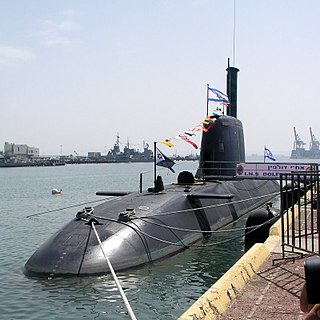
The Dolphin class is a diesel-electric submarine constructed by Howaldtswerke-Deutsche Werft AG (HDW) in Kiel, Germany, for the Israeli Navy. The first boats of the class were based on the export-only German 209-class submarines, but modified and enlarged. The Dolphin 1 sub-class is slightly larger than the German Navy Type 212 in length and displacement. The three newer air-independent propulsion (AIP) equipped boats are similar to the Type 212 vessels in underwater endurance, but are 12 metres (39 ft) longer, nearly 500 tonnes heavier in submerged displacement and have a larger crew than either the Type 212 or the Type 214.
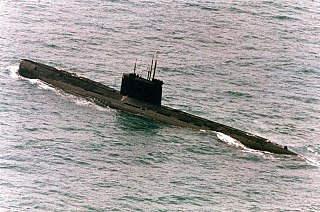
The Tango class was the NATO reporting name of a class of diesel-electric submarines that were built in the Soviet Union to replace the Foxtrot-class submarines assigned to the Black Sea and Northern Fleets. The Soviet designation of this class was Project 641B and it was also known as the Som (Catfish) class. The first of the class was completed in 1972 at Gorky. A total of 18 were built in two slightly different versions. The later type was several metres longer than the first, possibly because of the installation of ASW missile equipment.

Anti-submarine warfare is a branch of underwater warfare that uses surface warships, aircraft, submarines, or other platforms, to find, track, and deter, damage, and/or destroy enemy submarines. Such operations are typically carried out to protect friendly shipping and coastal facilities from submarine attacks and to overcome blockades.
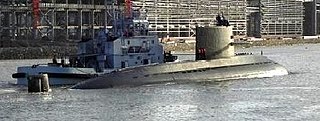
The Type 039A submarine is a class of diesel-electric submarine in China's People's Liberation Army Navy. It is China's first AIP powered submarine and presumed to be one of the quietest diesel-electric submarine classes in service. This class is the successor of the Type 039 submarine. The official Chinese designation is 039A as the ship is based on the 039 class, but as the 039A has very little resemblance to the 039 it is commonly referred to as the Type 041. The class is designed to replace the aging Type 033 and the older Type 035 submarines that previously formed the backbone of the conventional submarine force.
The People's Liberation Army Navy (PLAN) is the naval branch of the People's Liberation Army (PLA), the armed forces of the People's Republic of China. The PLAN force consists of approximately 250,000 men and over a hundred major combat vessels, organized into three fleets: the North Sea Fleet, the East Sea Fleet, and the South Sea Fleet.
The R-class submarines were a class of 12 small British diesel-electric submarines built for the Royal Navy during World War I, and were forerunners of the modern attack submarine, in that they were designed specifically to attack and sink enemy submarines, their battery capacity and hull shape being optimized for underwater performance.

The People's Liberation Army Navy Submarine Force (PLANSF) is the submarine service of the People's Liberation Army Navy. It consists of all types of submarines in operational service organized into three fleets: the North Sea Fleet, the East Sea Fleet, and the South Sea Fleet. Submarines have long been one of the three focuses of the People's Liberation Army Navy, and when the decision was made in late 2006 to concentrate on building other principal surface combatants to strengthen the air defense and to further delay the construction of aircraft carriers due to insufficient air cover, submarines will continue to play the lead dominant role in the assault force for the PLAN. Currently, PLANSF operates a fleet of 66 submarines which include nuclear as well as conventional submarines.

Naval tactics play a crucial role in modern battles and wars. The presence of land, changing water depths, weather, detection and electronic warfare, the speed at which actual combat occurs and other factors — especially air power — have rendered naval tactics essential to the success of any naval force.
The Type 032 submarine is a class of diesel-electric submarine currently undergoing testing in China's People's Liberation Army Navy. It is said to be the world's largest conventional submarine, at a submerged displacement of 6,628 tonnes and is able to submerge for a maximum of 30 days.

INS Kadmatt (P29) is the second of four anti-submarine warfare corvettes built for the Indian Navy by the Garden Reach Shipbuilders and Engineers of Kolkata under Project 28. She was inducted into the Eastern Naval Command of the Indian Navy.
The Type 035 submarine is a class of diesel-electric submarines of the People's Liberation Army Navy. The Type 035 is a heavily improved redesign of the older Type 033 submarines (Romeo-class), which were built in China from 1962 to 1984.
The Daegu-class frigate is a class of guided missile frigates of the Republic of Korea Navy (ROKN). The Daegu-class is based on the preceding Incheon-class frigate, and has otherwise been referred to an Incheon-class batch II, or FFG-II. Eight Daegu-class ships are planned, with the final goal of 20-22 frigates in the ROKN. The Daegu-class frigates are to be built by Daewoo Shipbuilding & Marine Engineering (DSME) and Hyundai Heavy Industries.
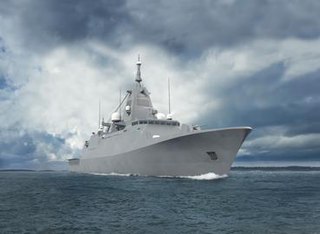
The Pohjanmaa class is a series of four multi-role corvettes currently under development for the Finnish Navy as part of the Squadron 2020 project. Together with the existing four Hamina-class missile boats, the four new surface combatants will form the backbone of the Finnish Navy from the mid-2020s onwards. They will replace seven older vessels that have been or are due to be decommissioned: the minelayer Pohjanmaa, two Hämeenmaa-class minelayers and four Rauma-class missile boats.
